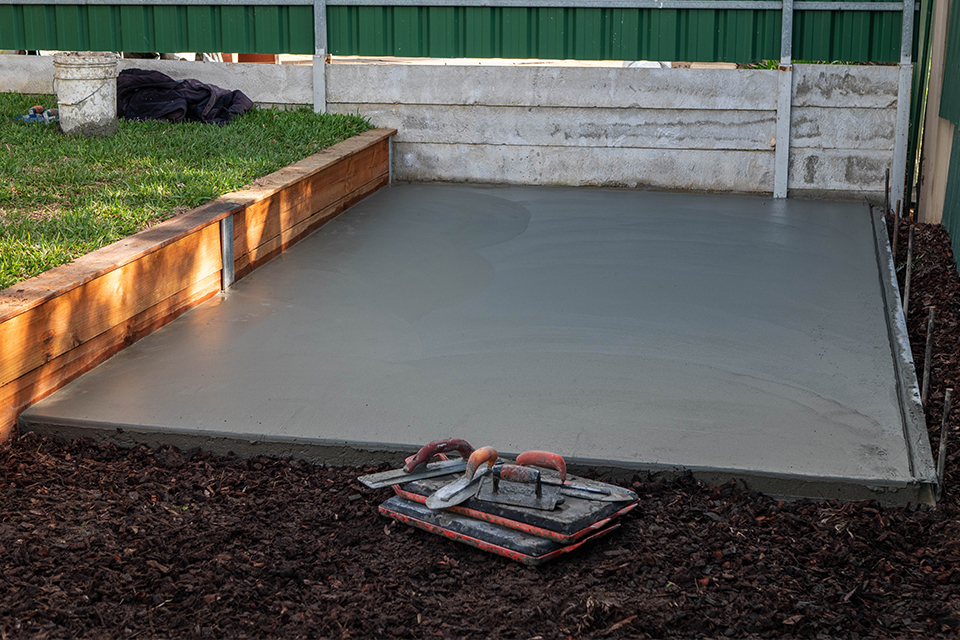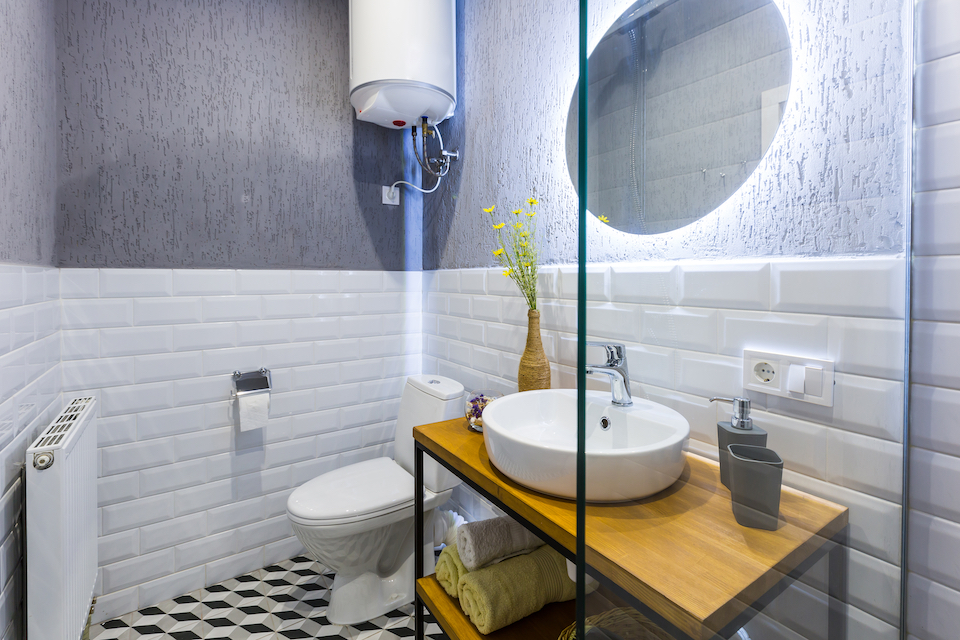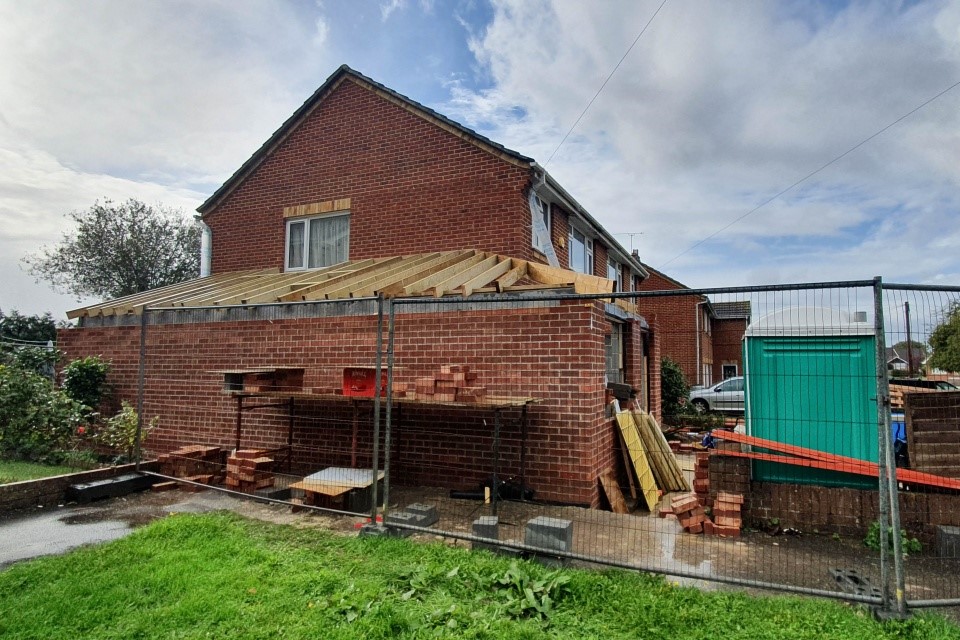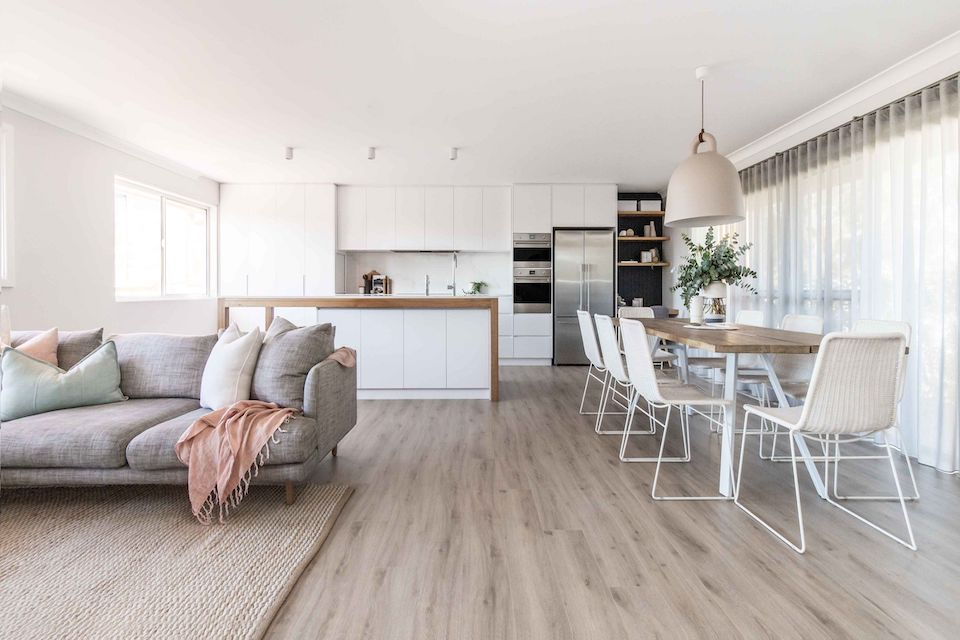How Much For a Concrete Base?
One of the most important parts of your shed and garden building is the foundation.
It not only provides security and a safe place for your garden shed to stand, but it also protects it from flooding, pests, as well as other damaging elements.
If you want to keep your shed, summer house, and log cabin for a long time, you need the best foundation. And if you want the best foundation, go with a concrete shed foundation.
Concrete bases outperform the competition in many ways, despite their simplicity of design.
In this section, we discuss the various costs of a concrete shed base.
Several factors could influence the final cost of building a shed base. For example, if you're proceeding to have deliveries as well as pour concrete, simple site access is essential. If you transfer the concrete with a wheelbarrow, your quote for a concrete slab will be higher.
The cost will be affected by whether the ground is already level, as the ground beneath your concrete slab must be level. There should be no visible sharp stones or sticks. Sharp objects may be able to pierce the damp-proof membrane.
So, how much does it cost to build a shed base?
Poured concrete ranges in price from £75 to £95 per M3. The concrete alone will cost around £40 for a small shed.
Concrete slabs can sometimes be obtained for free or at a low cost if you use them. The tradesman who arrives to lay your concrete slab might include removing any turf or soil in their quote.
If they don't, ask your neighbours, co-workers, family, and friends. Check with your local recycling centre or tip before you pay anyone to remove the turf and soil.
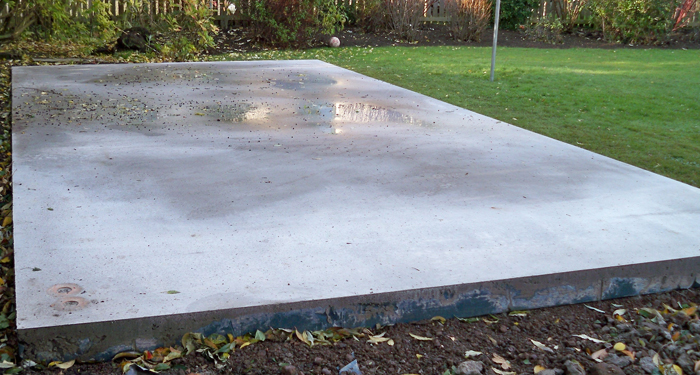
The price of pouring concrete is calculated per cubic metre (m3) rather than per square foot.
This is because, in most cases, you need to fill a certain volume rather than an area, so speaking in terms of square footage is difficult to translate.
The average cost of concrete pouring for grades C8/C10/C15 is around £90 - £100 per m3. For grades C20/C25, expect to pay around £100 - £110 per m3. The average price for grades C30/C35 is £110 - £120 per m3.
Alternatively, if you require grades C40/C45, the average cost of concrete pouring is around £130 - £140 per m3. If you're not sure how much concrete you'll need, seek professional advice from your local concrete pouring specialists.
Concrete Base Prices
The table below will break down the average costs to build a concrete shed base:
| Job | Cost |
|---|---|
| Poured concrete | £75 - £95 per m3 |
| Concrete pouring for grades C8/C10/C15 | £90 – £100 per m3 |
| Grades C20/C25 | £100 - £110 per m3 |
| Grades C30/C35 | £110 - £120 per m3 |
| Grades C40/C45 | £130 - £140 per m3 |
- How Much For a Concrete Base?
- What are the Supply Costs for Building a Concrete Shed Base?
- What are the Additional Costs of a Concrete Shed Base Installation?
- Tradesmen Costs for Laying a Concrete Shed Base
- How Long Does It Take to Build a Concrete Shed Base?
- Types of Concrete Shed Base
- How Much Does It Cost to Remove a Concrete Shed Base?
- FAQs
- Sources
What are the Supply Costs for Building a Concrete Shed Base?
A shed base requires only four materials: type 1 MOT, sand, cement, and some wood, though something as simple and inexpensive as edging boards will suffice. We'll only go over the supply costs here, so you know what to expect if you decide to do it yourself.
Most people purchase edging boards from Wickes because they appear to be the best deal, costing between £25 and £30 for a pack of 5'8 foot cutting boards. When you add all the sides of a 6 x 8 foot shed together, you get a total of 28 feet, which means we should have at least 10 feet left over.
However, don't forget to use pegs to hold the edging boards in place. We frequently find small strips of the baton, such as 2 x 1. Wickes sells packs of these for as little as £8 - £15. When constructing the wooden frame for your concrete shed base, you should spend no more than £45 on timber.
It is strongly advised to use type 1 MOT because it compacts the ground once tampered with, reducing the chances of the ground shifting and breaking your concrete slab in the future. So, depending on your finances, it is recommended to use it, but it is entirely up to you.
You should use 2 inches of type 1, which is equal to 50mm. One bulk bag of type 1 MOT should cover 8 square metres at a depth of 50mm, implying that one bulk bag would be more than enough and that smaller bags may be worth considering.
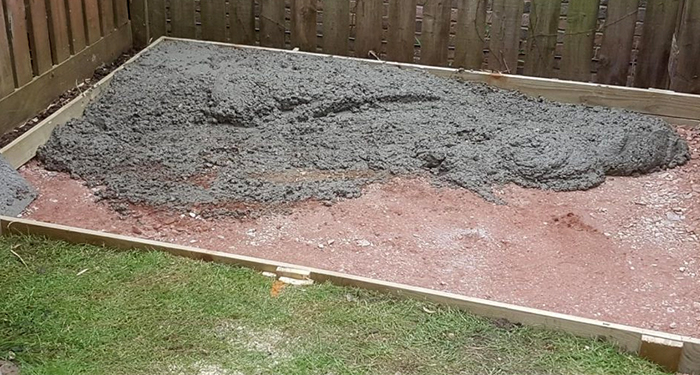
Although more expensive than buying in bulk, this will save you time and expense when it comes to disposing of any leftover hard-core.
You can pay £50 for each bulk bag. Remember not to have type 1 MOT at the border edges because once the concrete has been set and the boards have been removed, you will want to see a solid concrete foundation, not type 1 MOT coming out the sides!
Ballast is the best type of sand to use when constructing a concrete shed base. Bulk bags of this sand are the most cost-effective way to purchase it.
A bulk bag of ballast usually covers a large area. The ideal depth for the concrete foundation for the shed base is 75 – 100mm, which means you should be able to use one bulk bag of ballast.
It is recommended that for each bulk bag purchased, 4 - 5 bags of cement be purchased. A bag of ballast should not cost more than £50, and a bag of cement should not cost more than £5.00 (£25 for five bags of cement).
This brings the total cost of the cement and sand to £75.
The table below will break down the different supply costs of installing a concrete shed base:
| Supply | Cost |
|---|---|
| Edging boards | £25 - £30 |
| Pegs | £8 - £15 |
| Sand | £50 bulk bag |
| Cement | £50 bulk bag |
What are the Additional Costs of a Concrete Shed Base Installation?
When installing a shed base, you may decide to have additional work carried out to give your garden a brand-new look! Or sometimes, small details can add up to the overall cost.
Therefore, here we will go over the additional costs of installing a concrete shed base so you know what to expect.
Garden Renovation
It takes a lot of effort to make your garden look amazing. It's easy to put off, especially as the weather changes.
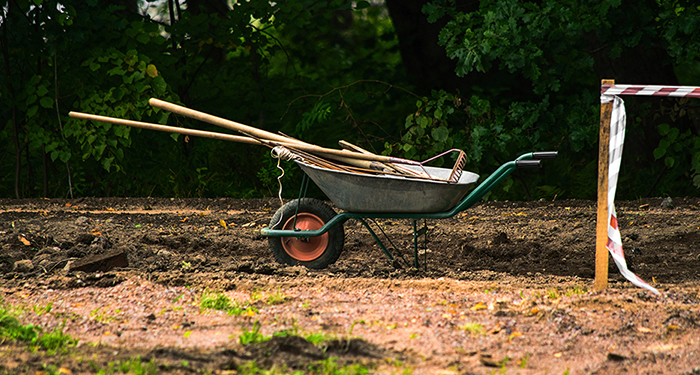
Finding a cost to renovate a garden is difficult because the overall cost is determined by the length of the garden, the form of renovation desired, and the number of labourers required for the job.
The garden design cost for a transformational task on a large back garden of 100 m2 will range between £5,000 and £10,000.
Planting a few small trees around the garden will provide a nice frame for it and will cost you nothing. Ornamental cherry trees, when in bloom, cost less than £50 per square metre as well as make an excellent decorative feature.
Generally, you'll need to employ a garden designer or landscaper. On average, expect to pay £100 per square metre for labour and materials.
If you're satisfied with the outcome look and just want to focus on planting, the total garden design cost could drop to £30 per square metre.
Please refer to our guide on garden renovation costs for further information.
Garden Waste Removal
The cost of having garden debris removed ranges between £70 and £200. The cost, on the other hand, will be determined primarily by the size of your garden and the amount of waste that needs to be removed.
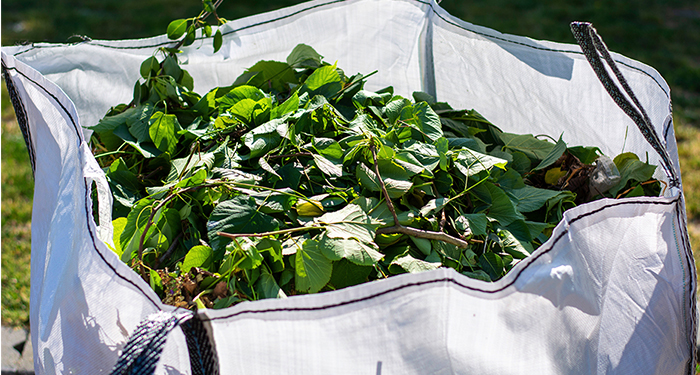
Green waste removal is estimated to cost between £100 and £150. The same can be said for brown waste removal. The cost of collecting soil trash is approximately £0.15 per kg.
One option is to rent a skip and afterwards fill it with your trash. The cost of hiring a skip range between £60 and £450, depending on the size of the skip needed.
Please refer to our guide on garden clearance and waste removal costs for further information.
Shed Installation
The typical cost of installing a wooden garden shed is likely to be between £500 and £5,050. A metal shed of average size will most likely cost between £300 and £2,200 to install. Installing an average-sized shed will likely cost between £345 and £3,200.
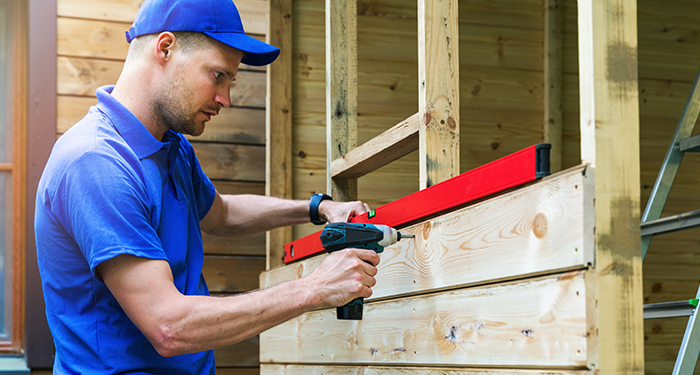
However, such costs can vary greatly depending on where you are in the UK, so the above cost estimate is only an average. An alternative to painting your shed is to have it stained, which will cost you between £100 and £200.
Please refer to our guide on shed installation costs for further information.
Fence Painting
The cost of having your fences painted varies depending on the number of panels you want to be painted and the size of the panels in question.
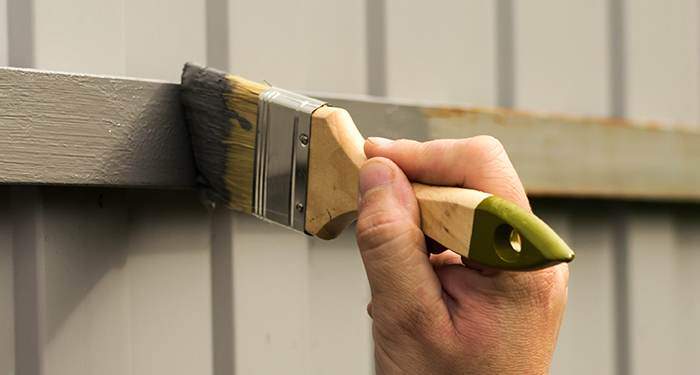
Painting 10-20 average-sized fence panels could take 1-2 days, with material costs ranging from £15 to £60.
When you add these costs to the daily charge of a professional, you'll probably end up paying somewhere between £175 and £380 to have 10-20 fence panels painted.
Location
Due to the fact tradespeople' prices vary across the country, where you live will have an impact on the cost of installing a shed base.
On the other hand, hiring costs in the southeast are usually higher than the national average, especially in London. However, costs in the north of England, Scotland, and Northern Ireland are generally lower than in the rest of the country.
Minimum Fee
Some tradespeople will charge a flat fee regardless of the size of the job, where about you live, or how long it takes the tradesperson to get to your home. This is unlikely to apply in most cases, but if it does, it will be added to your total bill.
Most tradespeople provide a cost breakdown on their website, which should give you all the information you require. If one is not accessible, you can always contact them by phone or email for more information on what prices will be featured.
Number of Tradespeople
The cost of installing a concrete shed base is also defined by the amount of tradespeople needed, which is impacted by the size/type of concrete base for shed needed. The more tradespeople needed, the more expensive the installation will most likely be.
Size
It comes as no surprise that the bigger the shed base, the pricier the repair. This is since a larger shed base will have higher labour and supply costs than just a smaller one.
Duration
The longer it takes to install the concrete shed base, the higher the labour cost. However, the longer the hiring time frame, the more you will pay, with some homeowners having to hire repairers for a few days or others for several weeks or months.
Tradesmen Costs for Laying a Concrete Shed Base
Concrete bases can be difficult to install. Of the two options, concrete is by the most labour intensive, and if installed incorrectly, it can be costly and physically demanding to remove and replace.
The labour costs for trying to install a concrete shed base range between £40 and £50 per m2. This can vary depending on the job's complexity and the time it takes to pour the concrete. Generally, you should budget between £220 and £450 per day for labour.
Make your decision based on the type and size of shed you want to construct. What you intend to store in it, the requirements of the location, and your budget all play a role in your decision.
A small shed has different needs than a large shed. Your choice is influenced by the open bottom or built-in floor, as well as the sloped or flat ground.
How Long Does It Take to Build a Concrete Shed Base?
When having work done, you may wonder how long it will take? In this section, we will go over the different durations it takes to build a concrete shed base and factors that could affect the overall timescale for this job.
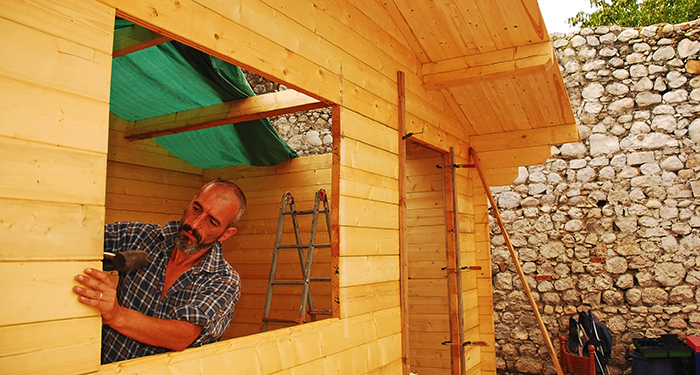
Concrete bases can take anywhere from 24 to 36 hours to lay and begin to set, depending on the installer's experience and the amount of prep work required prior to laying the material.
Most concrete bases require the installation of a border to prevent the concrete from spilling out, which is an additional job after preparing the ground and before laying the concrete. Once the base is levelled, it takes about seven days for the concrete to cure and be ready for a shed and garden building.
Most installers recommend using support structures all through your concrete base, which adds to the work. PSB does not require any support structures. Concrete should be 3 to 4 inches thick (75mm – 100mm) – plastic shed bases are only 40mm deep.
Concrete is a labour-intensive material that can take several hours to lay as well as level correctly if installed by hand. If done incorrectly, it can be expensive to replace and permanent.
PSB can sit at the top of a sub-base and protrude without the need for a border and work well. Concrete requires a solid border to make sure that it does not spill out of its place. PSB can sit on top of a sub-base and be bulging without the need for a border and work well.
Types of Concrete Shed Base
Concrete slabs are one of the most secure and safe garden building foundations you can make or buy. Concrete slabs can be built to exact specifications and serve as an extremely stable, weather-proof foundation for any wood, plastic, or metal structure.
What's more, it doesn't matter what was there before – a concrete foundation can go almost anywhere. Of course, nothing is perfect, and a concrete foundation has its own flaws, rather than flying through them, ignoring all their significant advantages.
We will go over the various types of concrete shed bases and their benefits and drawbacks in this section.
Concrete Pavers Cost
A simple shed foundation for the novice, suitable for pre-built or home-built sheds. A paver foundation is built on levelled exposed ground or sand. They provide a solid flat base for building or erecting a shed and evenly support the floor.
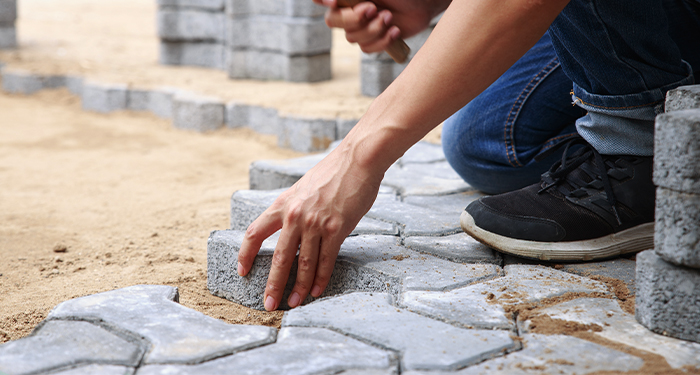
The larger the paper, the heavier it is, but the fewer pavers you require. Pavers work well on flat ground for smaller sheds made of wood, metal, or plastic, with or without a floor. The use of pavers places the entrance close to, or on, the ground, making it ideal for riding lawn mowers or quads.
Pavers are simple to install once the ground has been levelled. If the pavers are to be placed on sand, they must be levelled first. Sand also aids in the levelling of the pavers.
Cost is usually around £100 - £200. The price of pavers is determined by their size, colour, and shape. Large pavers with a steel mesh inside are available, but they are more expensive. 24"x24" or 24"x30" are my preferred sizes. Adding a sand layer raises the price as well.
Pros
- Available in different colours and sizes
- Quick and easy to install
Cons
- Can settle into the soil over time
- It can crack with heavy loads
Solid Concrete Blocks Cost
A relatively simple foundation for the novice and a good foundation for any size shed—ideal for prefabricated or custom-built sheds. Concrete blocks are rectangular or square in shape.
Use only solid concrete blocks. They sit on the ground and must be level with one another. The number of blocks required is determined by the dimensions of the shed and the slope of the ground.
To form a tower level with the other block towers on the sloped ground, stacked blocks may be required. Support the corners, as well as every 6' to 8' around the perimeter and in the middle. An 8'x12' shed would require six blocks, possibly more if levelling towers are used.
You are only levelling the foundation blocks, not the ground. The most difficult steps are levelling the blocks and squaring the corners. The difficulty level rises when the terrain is slanted.
It is usually around £100. The price of solid-concrete blocks is determined by their size and shape. The amount needed will be determined by the size of the shed and the gradient of the ground. The height you want the shed to be off the ground is also a consideration.
Pros
- Good for small sheds
- Easy to stack
Cons
- It can sink over time
- Not suitable for greater slopes
Gravel Pad and Timber Frame Cost
A simple foundation for any size shed, suitable for ready-made or home-built sheds. Because of the size, this is more difficult for the inexperienced DIYer.
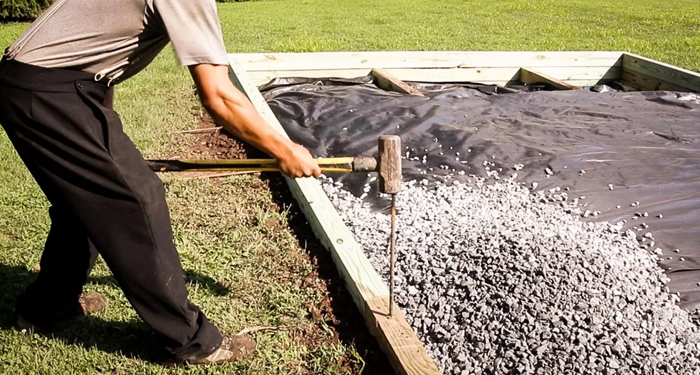
For flat ground, the gravel pad, as well as the timber frame foundation, are ideal. Use pit-run gravel or 1" crusher-run gravel. It contains smaller particles and forms a more stable base.
Compact the gravel with a gas-powered compactor, keeping the gravel level. The pad is on the floor and should be two feet wider and two feet longer than your shed.
Cover it with a garden cloth before spreading the gravel out and tamping it down. It should be level and 4"-6" thick. The size of the shed determines how much space you require.
Where the timbers meet, use a half-lap joint. Square the corners and make sure the lumber is level. Drill the joints and drive a length of rebar into the ground with a hammer.
Level the ground or conceal minor flaws beneath the level gravel layer. The most difficult steps for this foundation are levelling the 4"x4"s to each other and squaring the corners.
This cost between £200 and £400.
Pros
- Easy to level
- Easy to install
Cons
- High risk to rot
- Not suitable for slopes
Concrete Slabs Cost
A fantastic foundation for any size shed, ready-made or custom-built, garage, or even a two-story house. The various steps make this more difficult for the inexperienced DIYer, and it's a more difficult foundation to build.
The size of the shed determines how much space you require. The completed slab can support vehicles and sits on the ground, making it easy to drive into. Make sure you have entry to the concrete truck, as well as you may need to hire a pumper truck or a crane at an additional cost.
The gravel pad's perimeter should slope downward to 2" thick gravel for the outside 12"s of the perimeters. This creates a footing that aids in support of your building's walls. This type of foundation entails several steps. Because it is a permanent foundation, any mistakes will be permanent.
For a 300sqft pad, this costs between £2,500 and £4,000 (approximately). The cost of all the materials needed will vary depending on where you live. Rentals/hires of equipment and Building Code necessities also add to the cost.
Pros
- Permanent
- Support heavy loads
Cons
- It needs to be above freezing for pouring
- It can crack over time
The foundation you choose is an important choice. It keeps your shed level as well as dry as well as provides a stable foundation for it. All these things will help you to prolong the life of your storage shed.
Most on-grade shed foundations are simpler to construct and do not necessitate the use of specialised tools or knowledge.
You should pick the material that is suitable for the type of shed you want to support and the place you want it to be in. Many of your questions can also be answered by your Building Inspector.
Permanent foundations are more complicated and may necessitate more skill. This doesn't mean you can't do it; it just means you need to learn more about the foundation you want to use.
How Much Does It Cost to Remove a Concrete Shed Base?
Tradespeople aren't always there to add things to your home; sometimes, they're there to take things away.
Removing elements from your home that you no longer want, whether it's a shed, a wall, or even the entire property, can be a specialised job, especially when hazardous materials are associated, but it can be necessary to do on its own or as part of a larger project.
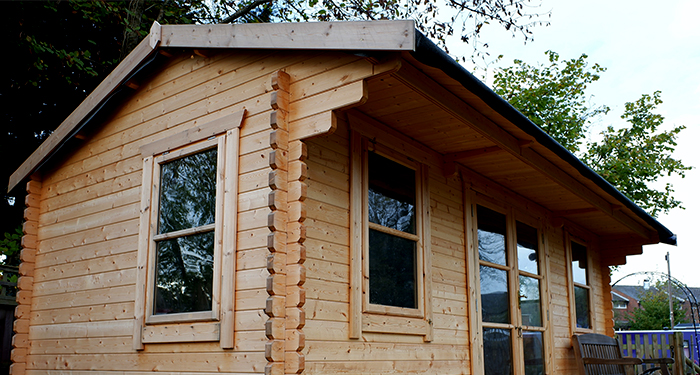
We'll go over how much it costs to eliminate a concrete shed base in this section.
Concrete shed bases are subject to the general rule of £50 per metre square. The total cost of removing a concrete shed base ranges between £1,500 and £2,500.
However, if the base is larger than average or needs specialised equipment, the price may rise.
Concrete shed bases are frequently constructed from concrete slabs embedded in mortar. A tradesperson will typically charge around £150 per day to eliminate a concrete shed base, but they rarely work alone, so budget an additional £100 per day for a labourer.
FAQs
Q: How much concrete do you need for a shed base?
A: A standard concrete mix ratio of one part cement to five parts ballast (aggregate and sand) is usually sufficient for shed bases, but reinforcing fibres can be added if you are housing anything particularly heavy.
Q: How thick should a concrete base be?
A: In most cases, a thickness of 3" (75mm) is sufficient for ordinary garden sheds. If the clay is soft or the building is large, increase the depth to 4" (100mm) laid on 2" (50mm) of finely cracked and compacted hard-core.
Q: Is concrete the best base for a shed?
A: Concrete is ideal for constructing a sturdy, long-lasting foundation for your garden shed. The first step is to mark out the area where the concrete would be laid, adding 100mm to the finished shed's width and length to allow for a small edge around the base.
Q: Does a concrete base need a membrane?
A: A damp-proof membrane should be installed in the concrete or slab base, sized to the whole surface area the shed will occupy. This should be installed 2" below the concrete slab's surface or beneath the flags. Make sure the slab's or concrete foundation's surface is at least 2" above adjoining soil levels.
Q: What size should my shed base be?
A: Your base should be roughly the same size as your shed's floor. Some people prefer to build a larger foundation or lay paving slabs around the perimeter of their shed. This provides easier, cleaner access as well as space to empty items onto a hardstanding area.

